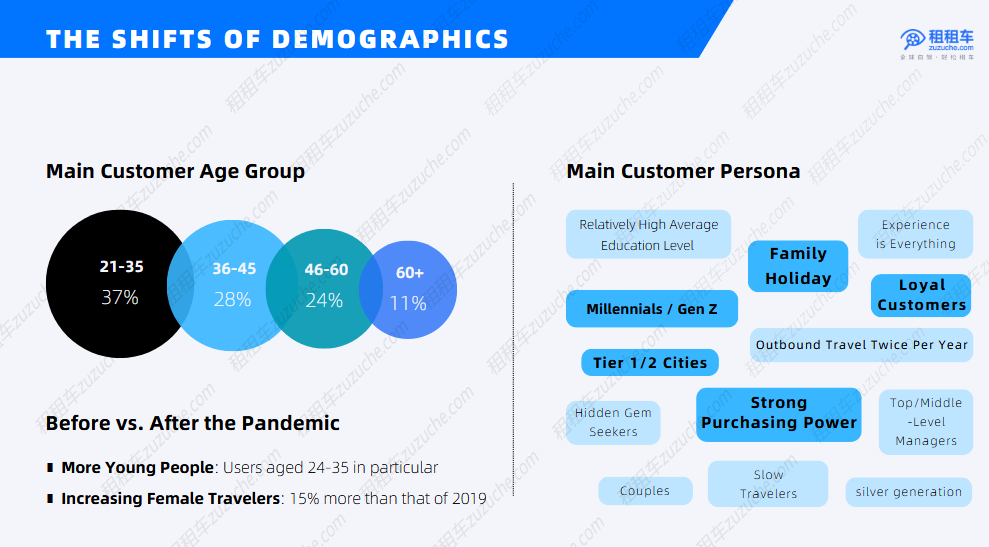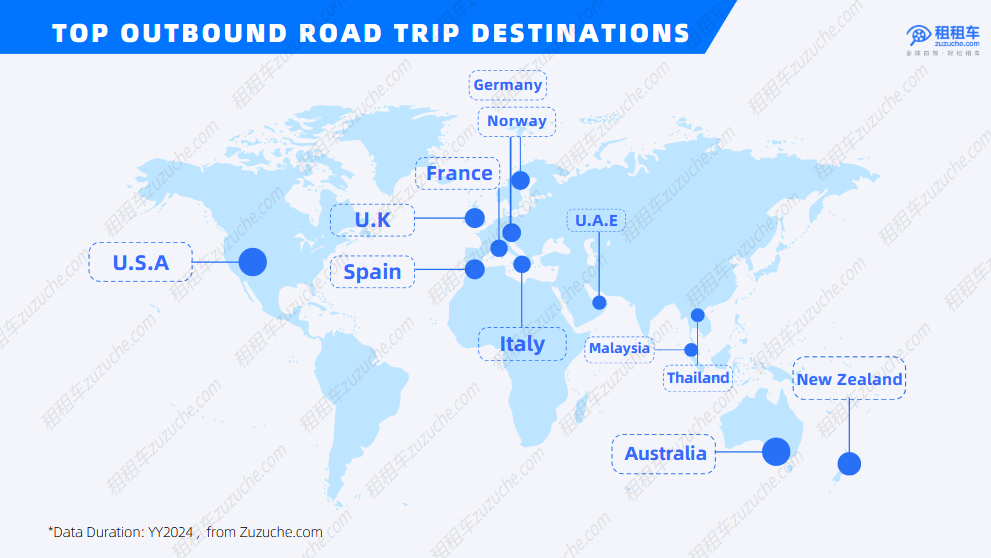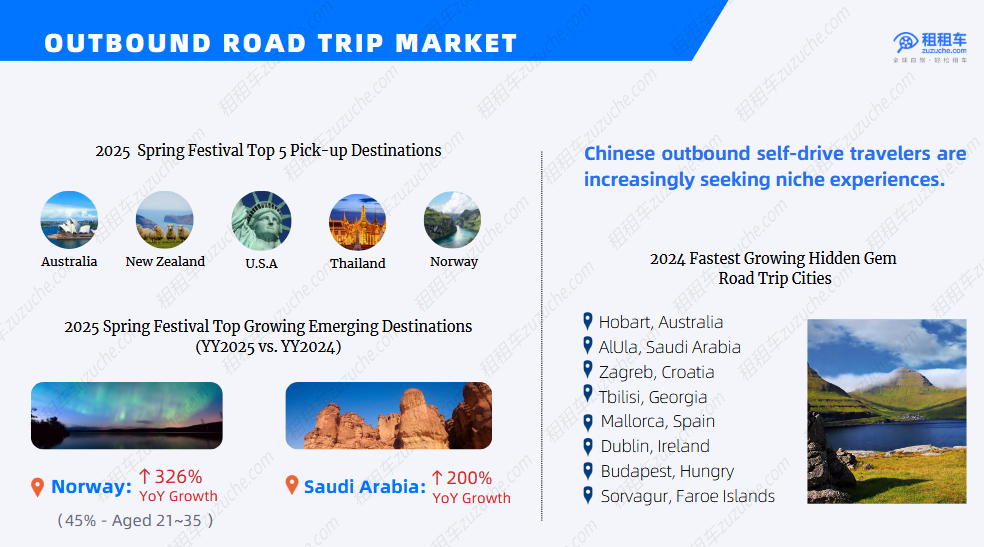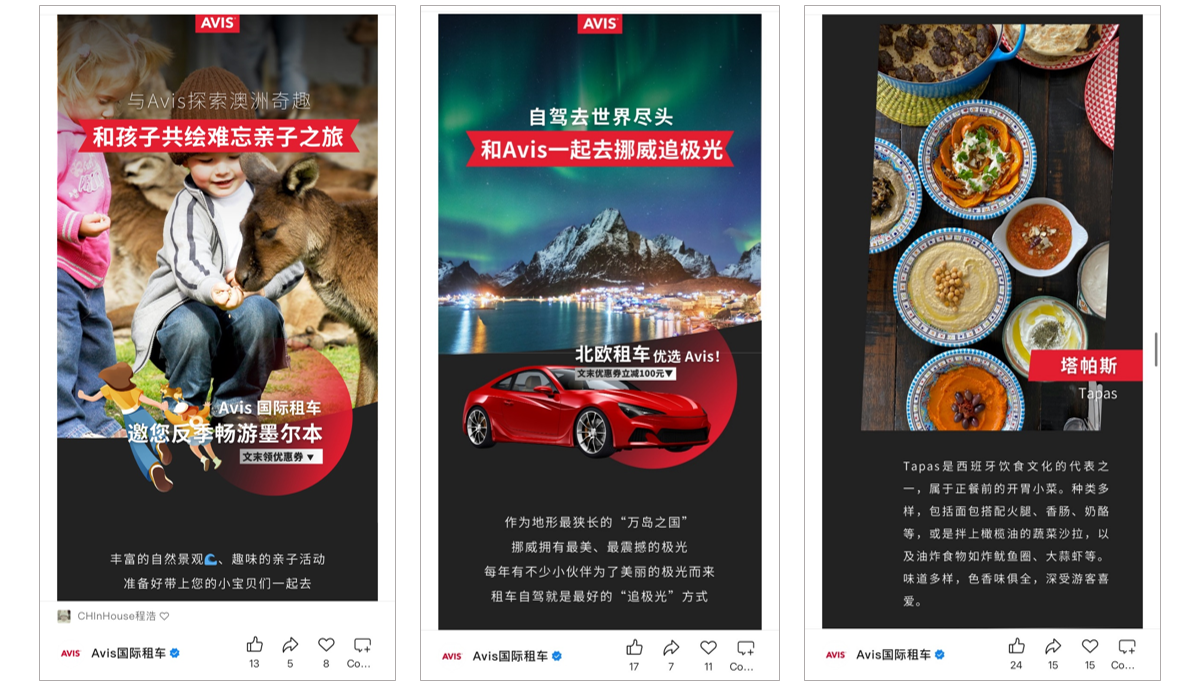
Norway has emerged as a dark horse among the most popular road trip destinations for Chinese travelers. Photo by Tord Sollie for Unsplash
Chinese tourists have fully embraced the road trip for both domestic and outbound travel. Following our February 2025 webinar with China’s largest road trip service platform, Zuzuche, here are eight things travel brands need to understand in order to reach the growing market of self-driving Chinese travelers.
1. The market is only getting bigger
Self-driving was already a growing trend for Chinese outbound travel before the pandemic – Dragon Trail wrote about it in 2017 and again in more depth in 2019. But its potential has expanded considerably since then. In 2020, the China Tourism Academy found that 42% of Chinese would choose to travel domestically by car. By 2024, China’s Ministry of Transport revealed that 80% of domestic travelers over the National Day holiday chose to go by car, marking a major cultural shift in travel preferences.
As of Q4 2024, Zuzuche has helped more than 20 million Chinese to obtain internationally certified translations of their driver licenses, with a 331% year-on-year increase in users booking this service between 2022 and 2023. Moreover, their repurchase rate for overseas car renters is more than 70%, showing that travelers who try driving overseas are likely to make this a preferred mode of travel for future trips.
2. More Chinese women are renting cars overseas
One of the biggest demographic shifts that Zuzuche has seen post-pandemic among outbound travelers is the increase in women renting cars, up by 15% in 2024 compared to 2019. For now, though, men still make up the large majority of drivers. During the 2025 Chinese New Year period, the gender ratio was 72% male and 28% female. Older women are a particularly important segment here, with 30.8% of women who rented cars over Chinese New Year aged 55 or older.

Data: Zuzuche
3. Young Chinese have embraced the road trip
While China’s increasingly important silver travel market is also part of the road trip trend, younger travelers are the biggest group, and that’s something that’s strengthened since the pandemic, particularly for users aged 24-35, who make up 37% of Zuzuche’s outbound travelers (vs. just 11% aged 60+). Young travelers are driving forward new trends, too, particularly in terms of pioneering new destinations. Zuzuche’s data shows that 45% of travelers to dark horse hotspot Norway this Chinese New Year were aged between 21-35.
4. Growth destinations reveal diverse travel trends
Zuzuche’s top 2024 road trip destinations cover much of the world. The USA remained one of the most popular destinations, as it was before the pandemic. Australia and New Zealand were in the lead during Chinese New Year 2025. Western and Northern Europe featured prominently on the top 12 list, with the UK, Spain, France, Germany, Norway, and Italy all represented. In Asia, Southeast Asian hotspots Thailand and Malaysia were both also favored by self-driving tourists. And standing out in the Middle East, the UAE also made the list.

Data: Zuzuche
Top-growth destinations for 2025’s Chinese New Year holiday reveal just how widely Chinese tourists are exploring the world by car, with 200% year-on-year growth in Saudi Arabia – where AlUla is particularly popular, and a staggering 326% year-on-year growth in Norway, a “dark horse” destination which is enjoying surging popularity this year for travelers seeking the Northern Lights.
Zuzuche’s list of 2024’s “fastest growing hidden gem road trip cities” also highlights how Chinese travelers are seeking out new, niche, off-the-beaten-track travel destinations – and what better way to reach them then by car? These include Hobart, Australia; Zagreb, Croatia; Tbilisi, Georgia; and Sorvagur in the Faroe Islands – Chinese citizens need a separate visa just to visit, but even that didn’t stop it becoming a trending destination during the summer of 2024.

Data: Zuzuche
5. Road trips are a top choice for Chinese families
Renting a car can afford families greater flexibility, comfort, and privacy for travel, and it’s an increasingly popular choice for both two- and three-generation family groups at Chinese New Year. Zuzuche’s data reveals this clearly, with a 40% year-on-year growth in SUV rentals, and an even more impressive 262% year-on-year increase in rentals of 7-seater cars during Chinese New Year 2025.
6. Social media plays a key role for Chinese road trippers
As independent travelers, self-driving Chinese tourists are nearly guaranteed to be using social media platforms to research, plan, and later share their trips overseas, with Xiaohongshu as the most popular trip-planning app at the moment. Realizing this, Zuzuche has developed its social media presence with more than 80 social media accounts across Chinese and Western platforms, more than 300 million month impressions, and more than 1,000 influencer partners.
Social media is the right place for travel brands to connect with Chinese self-driving consumers, which can mean publishing inspiring and informative content, working with influencers, and going further to create resources such as WeChat mini-programs, and promoting links from social media to booking pages.
7. Chinese travelers face many obstacles to driving overseas
Chinese travelers who want to drive overseas do face numerous barriers, starting with their licenses, which must be officially translated and are still not accepted in all countries and territories (notably, not in Japan). On the road, they’ll need information to help them understand the destination’s traffic rules, and about their rental car’s rules, too – for example, relating to deposits or requirements to return the car refueled. Ideally, this information should be available in Chinese, or English as a minimum. Navigation systems are another issue, as Chinese drivers often find that using the GPS that comes with rental cars in foreign countries can be confusing.
Zuzuche aims to address all of these challenges through their services, including free driver license translation, 24/7 emergency assistance in Chinese, driving guides, and Chinese-language offline map navigation app.
Dragon Trail also recommends that car rental providers catering to the Chinese market prepare information and communicate with Chinese clients about driving rules and rental fees in Chinese (ideally) and/or English.
8. There are many ways tourism brands can tap into the Chinese road trip trend
Destinations and other tourism brands can leverage the self-driving trend to engage and attract Chinese visitors. Articles outlining themed road trip itineraries tend to be very popular on WeChat – for example, fall foliage in Canada, Christmas markets in Germany, or food in Spain.
Self-driving can also be used as a theme for a bigger campaign. For example, Dragon Trail worked with the German tourism board and Lufthansa to launch an H5 self-driving guide in 2016. In 2018, we worked with Visit Florida to send five Chinese KOLs to explore the state, in cars sponsored by Hertz, with a campaign that received more than 57 million views.

Themed guides to overseas road trips shared by Avis on WeChat: Family travel in Australia, the Northern Lights in Norway, and food in Spain
Additionally, Dragon Trail has worked with leading international car rental companies over the years, including Hertz, Avis, and Europcar. In 2024, we started tracking car rental companies in our WeChat rankings, and from this we can already see how car rental companies can get more views for content that taps into current tourism trends and popular destinations, like Hertz’s guide last year to self-driving in Norway.
Zuzuche also provides opportunities for market to overseas travel brands. They’ve partnered with more than 50 tourism boards, helping to promote destinations to Chinese drivers through multi-channel marketing, including through sales promotions and free downloadable guides to traffic rules and road safety. With nearly a decade working with Tourism New Zealand, self-driving travelers have risen as a percentage of Chinese visitors to New Zealand from 20% to 39%. Zuzuche has also run coop campaigns with airlines, and car rental brands, hotels, retailers, car brands, and payment services.
This article is based on Dragon Trail’s February 2025 webinar with Zuzuche. You can watch the webinar recording here, and contact us directly to request the presentation slides.
If you’re a destination, car rental company or other business that would like to find out more about digital marketing to attract Chinese outbound travelers and how Dragon Trail can support you in your marketing activities, get in touch today to request more information and set up a meeting.
Sign up for our free newsletter to keep up to date on our latest news
We do not share your details with any third parties. View our privacy policy.
This website or its third party tools use cookies, which are necessary to its functioning and required to achieve the purposes illustrated in the cookie policy. If you want to know more or withdraw your consent to all or some of the cookies, please refer to the cookie policy. By closing this banner, scrolling this page, clicking a link or continuing to browse otherwise, you agree to the use of cookies.